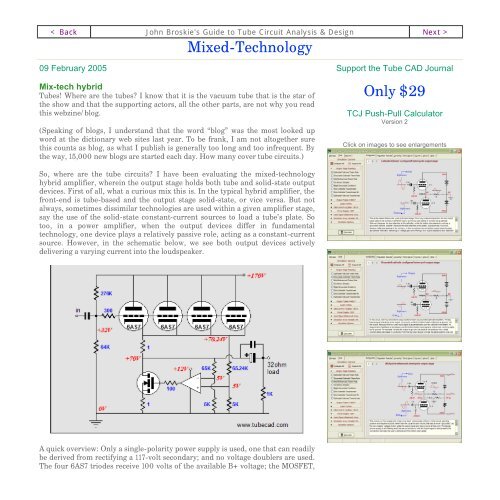Mixed-Technology Only $29 - Tube CAD Journal
Mixed-Technology Only $29 - Tube CAD Journal
Mixed-Technology Only $29 - Tube CAD Journal
You also want an ePaper? Increase the reach of your titles
YUMPU automatically turns print PDFs into web optimized ePapers that Google loves.
One workaround would be to replace the plate resistor with an inductor, whichwould effectively double the B+ voltage. Such a replacement would give the 6N1Pplenty of voltage to work with, as almost the full 160 volts would be available.However, such a move is dangerous when a global feedback loop is added to themix, as the inductor brings its own set of problems, such as resonance and phaseshifts, which can easily turn an amplifier into an oscillator.Thus, in this circuit, with this limited B+ voltage, it should be obvious that the6DJ8 is a better choice, but let us see if we cannot make the 6N1P work through aspecial technique.TCJ PPC Version 2ImprovementsRebuilt simulation engineCreate reports as PDFs*More Graphs 2D/3D*Help system addedTarget idle current featureRedesigned array creationTransformer primary & secondaryRDC inclusionSave user-defined transformerdefinitionsEnhanced result displayAdded array result grid*User definableBootstrappingThe circuit above may not look that different from the first version, as it holds thesame number of parts, but it is wired differently. The driver stage’s plate resistor isTCJ Push-Pull Calculator has but a singlepurpose: to evaluate tube-based output stagesby simulating eight topologies’ (five OTL andthree transformer-coupled) actual performancewith a specified tube, power supply and biasvoltage, and load impedance. The accuracy ofthe simulation depends on the accuracy of thetube models used and the tube math model isthe same True Curves model used in
ootstrapped to the output stage’s output, which effectively boosts the B+ voltageby the amount of peak output swing, which in this case is about 36 volts. Soeffectively, the B+ available to the driver stage is not 160 volts, but 196 volts, at thetop of the grid swing. This means that we can set the idle plate voltage 36 voltshigher than with a fixed 160-volt B+ voltage. In other words, we can use 196 – 74volts, which equals 122 volts; instead, of 160 – 74 volts, which equals 86 volts. Theresult is that the lowest plate voltage swing will only extend down to 48 volts, not12 volts. So, how well will the 6N1P work with this setup?GlassWare's SE Amp <strong>CAD</strong> and Live Curvesprograms, which is far more accurate than theusual SPICE tube model.Download or CD ROMWindows 95/98/Me/NT/2000/XPFor more information, please visit our Website :www.glass-ware.comTo purchase, please visit our Yahoo Store:http://store.yahoo.com/glasswareWith a 37k plate resistor and an idle current of 1mA, the 6N1P would work, butthis is still a trivial amount of current. Now, let’s see how well the 6DJ8 works.
Back to the 6DJ8The 6DJ8 draws 15mA at 48 volts with 0-grid volts. 148 volts divided by 0.015Aequals roughly 10k, which means an idle current of 7.5mA would allow asymmetrical swing of 74 volts on the plate. Much better. Now, we add frosting tothe cake.The 6AS7 is not linear a tube. —I have been told that some believe that it is a closerelative to the 2A3. How so? Well, it looks like a 2A3 and the same company thatcreated the 2A3 created the 6AS7. Sure, just as George Bush is a close relative toJohn Kerry, as both are white men that went to Yale. I would love to know whostarted this nonsense. The 2A3 is nothing like a 6AS7, as they differ in every keyelectrical characteristic and even in fundamental construction, as one holds adirectly heated cathode and the other indirectly heated cathode.— And itsnonlinearity shows with a brutal 128-ohm load-line (32 times 4, as there is fourtriodes working into a 32-ohm load). In other words, it only takes 38 volts (fromgrid to cathode) to completely turn on the 6AS7, but it would take closer to 50volts to turn it off. A feedback loop will work to create this asymmetrical drivesignal in the process of straightening out the 6AS7.A 6N1P is definitely not adrop in replacement for
Using a 6DJ8 with a plate resistor of 16k and an idle current of 5mA allows us tolower the plate voltage at idle to 116 volts, which will allow the 6DJ8’s plate toswing +80 volts and –96 volts relative to ground and +54 volts and –60 voltsrelative to the output, because of the bootstrapping.the 6DJ8Therefore, in this circuit, a 6N1P is definitely not a drop in replacement for the6DJ8. Of course, if we use a higher B+ voltage for the input and driver stage, thena 6N1P could be profitably used.//JRB
Back www.tubecad.com Copyright © 1999-2005 GlassWare All Rights Reserved Next >

















